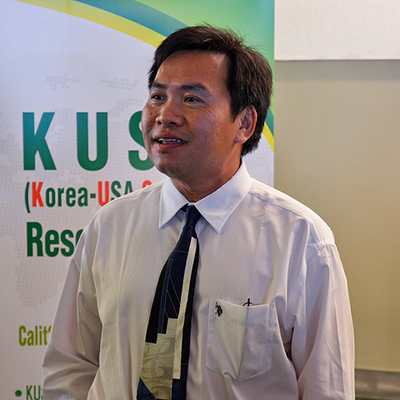Using electrical and computer engineering to tackle dominant medical challenges
Electrical and Computer Engineering is at the forefront of medical advancements as it creates solutions for increasing medical needs. Wearable electronic devices to detect, determine, and monitor patient activity and state as well as higher resolution imaging programs and devices are but only a few of the breakthroughs with which electrical and computer technology has revolutionized the medical field. The Medical Devices and Systems Initiative, i.e. MDS Initiative, established by the Electrical and Computer Engineering Department (ECE) at the University of California, San Diego, is working on various prototypes and topics that utilize engineering to solve medical problems. Combining efforts between ECE faculty members and the UCSD medical community, experts hope to further apply engineering competencies to the needs in the medical field.
Directed by Dr. Dan Sievenpiper and headed by Dr. Truong Nguyen, chair of Electrical and Computer Engineering Department at UCSD, the MDS Initiative is comprised of experts in circuit, photonics, machine learning, and other subsectors of engineering who partner with members of the UCSD Medical Center and the Veterans Affairs (VA) hospital. When the idea of the initiative formed in March 2014, the founding members asked for proposals from ECE faculty members; six of the nine proposals were then selected and are currently in development. All six projects are multi-year projects, aiming to showcase prototypes during the Alumni Day at UCSD in the beginning of June 2015.
The six projects in development include:
-
Compact, Invisible, and Solar Powered Wearable Electronics: Our well-being calls for technologies that can continuously monitor our health and performance, anywhere, without any burden of weight, size, power, or appearance. These technologies should be highly sensitive to chemicals, electrical signals, and pressures that are accessible from our skin surface and should transmit this measured data for real-time evaluation and feedback. Such information can be critical in avoiding seizures, heart attacks, organ failure, as examples, and aid primarily in disease prevention and life saving. They can also tells us about the performance levels of our brain and body and guide us to optimal and healthiest lifestyles. Nanotechnologies being developed at the Integrated Electronics and Biointerfaces Laboratory are specifically designed to meet such needs and to revolutionize wearable healthcare devices as we know them today.
-
High Fidelity, Self-Fitting Hearing Aids for Affordable Hearing Healthcare
-
Autonomous Multiday Human Brain Mapping: Translating advances in neuroscience into effective treatments for neurological and psychological disorders relies upon linking brain activity and behavior with high fidelity. Novel implantable neural interfaces are poised to scale clinical brain-mapping resolution by a factor of 10-100x within the next decade. Capitalizing upon these advances requires a complementary scale up in the duration and precision of clinical behavioral monitoring. This project enables such measurements by augmenting the capabilities of the epilepsy monitoring unit (EMU). Patients with epilepsy resistant to treatment are admitted to the EMU at hospital centers to monitor brain activity continuously for days by surgically implanting electrodes in and/or on the brain. Brain maps generated from this monitoring are used to plan for surgical interventions in which the diseased tissue is resected while avoiding the potential for introducing behavioral impairments. Currently, very little of the information collected during the patient’s stay is used to produce these maps – primarily only brain activity around recorded seizure events and behavioral responses to manual and intensive electrical stimulation of the electrodes. Employing computer vision methods, this work will develop a sensor system and new analysis methods to utilize significantly more of the valuable recorded brain activity by automatically and continuously measuring patient behavior and experience. These tools will advance current brain mapping techniques and will scale to complementary advances in neural recording technology. Furthermore, these augmented measurements will enable detailed studies of epilepsy that could lead to new treatment insights. Beyond these direct clinical applications, the detailed recordings of behavior and brain activity will enable a wide range of human neuroscience and neural prosthetic design studies.
-
A High-Density Peptide Array with Electrochemical Sensors for Immunosignaturing: Access to effective healthcare is a universal need for all of the nearly seven billion people worldwide. In particular, infectious diseases such as human immunodeficiency virus (HIV), Tuberculosis (TB), Dengue Fever, and Ebola (EboV) represent significant global health threats, yet the frequent and pervasive testing required for full control or universal eradication remain out of reach in many settings due to the costs and limitations of current technologies. We hypothesize that this pressing need can be addressed using semiconductor-based technology coupled with high-density in-situ synthesized peptide arrays for rapid, point-of-care diagnostics.
-
Super Resolution Ultrasound Imaging and Therapy Beyond Transitional Limit
-
Point-of-Care Device for Cancer Diagnosis and Prognosis
Bio
The Electrical and Computer Engineering Department (ECE) started the Medical Devices and Systems (MDS) Initiative as an effort to encourage collaboration between ECE and the UCSD medical community. The goal of this program is to combine research, education, and outreach in an initiative that brings the engineering and systems expertise of the UCSD Electrical and Computer Engineering Department to relevant problems in the rapidly expanding medical device field. This initiative includes seed efforts in a variety of areas with the aim of producing sufficient data to support larger external funding. Each program is collaborative, so that it includes the perspectives of at least two engineers from different disciplines, as well as medical doctors. The projects include the effort of graduate students, undergrads, and potentially high school students at all levels of technical contribution. It is expected that this effort will expand in the future, with the eventual goal of forming a larger government funded or industrial collaboration funded center.
Conceived around March 2014, the MDS Initiative now comprises of 6 principal investigators for six different projects and nine other ECE faculty members. ECE principal investigators in partnership with members of the UCSD Medical Center and VA Hospital were challenged to apply electrical and computer engineering core competencies to needs in the medical field.
The MDS Initiative has also built three lab spaces with equipments, shared between the six projects and encouraging joint effort. Another vision of MDS Initiative is to offer outreach programs to undergraduate and high school students.
The IEBL team, led by Prof. Shadi Dayeh of the ECE department at UC San Diego, has developed a provisionally patented technology that allow us today to build compact sensors on the most sophisticated integrated technologies and to do so on layers that are as 10-100 times thinner than a human’s hair. Prof. Shadi Dayeh has over 15 years experience in making advanced electronic sensors and devices on flexible substrates and on high performance materials. His lab specializes in heterogeneous integration of nanotechnologies for a variety of applications in energy harvesting and storage, low and high power electronics, wearable electronic devices, and neural probes. His electronic materials training covers a broad spectrum covered in academia, industry, and the government labs, where Prof. Dayeh was a Distinguished Oppenheimer Fellow at Los Alamos prior to joining UC San Diego. His work is widely published, highly cited, and internationally and nationally visible. More about his research can be found here: http://iebl.ucsd.edu
For more information, visit: http://www.ece.ucsd.edu/node/2795
In the News
October 1, 2013, IEEE Spectrum
August 7, 2013, Jacobs School News, Pule Magazine
Center for Integrated Nanotechnologies, Los Alamos and Sandia National Laboratories Annual Report, pages 14-15
May 14, 2007, Eurekalert
Publications
Awards
Advanced Substrates and Next Generation Semiconductors Workshop, Winner of Student Paper Competition, 2008
Shadi Dayeh
34th Conference on Physics and Chemistry of Semiconductor Interfaces (PCSI-34) Young Scientist Award, 2007
Shadi Dayeh
Material Research Society (MRS) Best Poster Award, Spring 2007
Shadi Dayeh
Material Research Society (MRS) Graduate Student Award, Spring 2007
Shadi Dayeh
Electronic Materials Conference (EMC) Outstanding Oral Presentation, 2006
Shadi Dayeh


